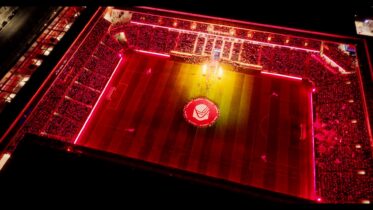A combination of Samsung’s Tizen operating system and more powerful System-on-Chip (SoC) smart displays may end the need for PCs in many or most digital signage projects.
All-in-one commercial displays have been touted in the digital signage industry as a way to cut out the cost and complexity of PCs, and offer a streamlined option for end users. But early versions from Samsung, which pioneered “smart signage,” and from competitors that have since debuted their own “smart” commercial displays, saw only modest market adoption because of limitations in their presentation capabilities.
However, with the fourth generation of Samsung Smart Signage displays now coming on the market, that’s about to change. In addition to having superior processing and graphics horsepower, the SoC processors in these new displays are running Samsung’s own Internet of Things-ready operating system, Tizen, which is set to have a major impact on the digital signage industry.
What Is Tizen?
Tizen is a cross-architecture, open-source software platform built on the Linux kernal and providing compatibility with HTML5. It’s the same open-source OS that runs Samsung’s latest smart TVs, as well as everything from wearables to connected car devices. Whereas earlier versions of the Smart Signage Platform (SSP) were somewhat limited in what they could display, Samsung’s Tizen is entirely web-compatible, supporting animated graphics and HTML5 content.
What’s the Big Deal?
Tizen offers many advantages for smart displays, including:
- Faster loading time on devices than Linux, due to its leaner design
- An upgraded graphics engine that gives the newest Smart Signage displays three times the animation performance previously available
- Web-based services and HTML5 support that make Tizen-powered displays more open and accessible to a larger pool of web and mobile developers beyond the traditional digital signage industry
What’s New for Smart Signage?
With Tizen, the fourth generation of the Samsung Smart Signage Platform offers a stronger, faster and more stable performance than earlier generations.
By running a full Webkit web browser, digital signage network operators and their creative teams are no longer constrained by what looked “just OK” on earlier smart screens. Graphic animations that might have sputtered or not shown correctly on previous models will now look as good as they do on a tablet or PC desktop. Like previous versions, the new Tizen-powered Smart Signage Platform also also supports full 1080p HD, 30 frames-per-second video and IPTV streaming.
Additionally, the fourth generation Smart Signage Platform offers new developer tools for software partners working on the platform, making it easier and faster to develop and test solutions.
The UK-based digital signage software firm Signagelive has deployed roughly 10,000 Samsung Smart Signage displays globally, including more than 1,000 for an Australian wireless retailer. “The key for us is that we can do more and in a better way,” says CEO Jason Cremins.
PC-Free Future
In September 2016, Samsung started shipping a set of mid-range and premium Smart Signage displays in multiple sizes. Going forward, new products equipped with SoC will ship with and run on Tizen.
Kevin Schroll, director of Samsung Electronics America’s Smart Signage product group, says the platform has evolved and matured to the point that marketplace adoption is now accelerating. “Customers like the simplicity and cost-effectiveness of the SoC displays,” says Schroll. “SoC is where everything is going. Within a few years, you are only going to see separate media players for super high-end 4K, feature-rich environments. Everything else can be driven by Smart Signage with embedded SoC media players.”
Cremins agrees. “Look at what our company and many others will ultimately do with this. We’ll go and build a custom application, a custom experience with touch, with interactivity and all those other things, and deliver it on a very capable device, that can play this content back and it won’t be lagging. Then you start adding web triggers for content, and device management, and you’ve pretty much got everything you need for digital signage inside that display.”
Cutting-edge digital signage technology continues to push the boundaries in industries such as retail. See how Samsung recently debuted its interactive mirror displays at New York Fashion Week.








